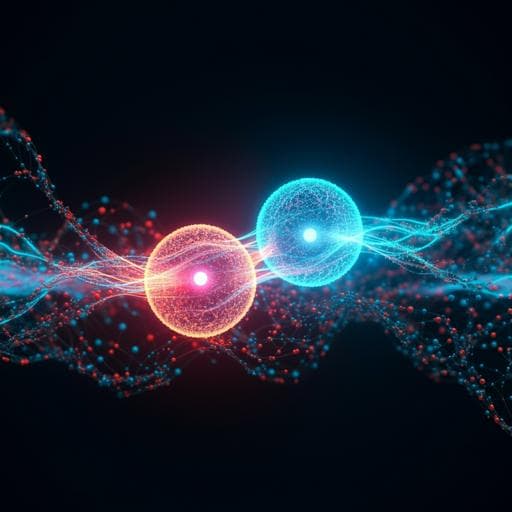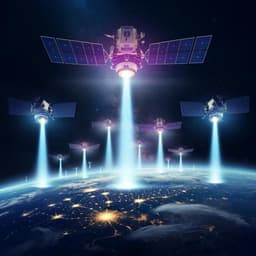
Physics
Oscillating photonic Bell state from a semiconductor quantum dot for quantum key distribution
M. Pennacchietti, B. Cunard, et al.
This groundbreaking research showcases a highly efficient source of entangled photon pairs generated from an InAsP quantum dot within an InP nanowire, achieving a remarkable high fidelity of 97.5% ± 0.8%. The study tackles crucial challenges in quantum key distribution through an innovative time-resolved protocol, promising advancements in secure communications. This research was conducted by a team of experts including Matteo Pennacchietti, Brady Cunard, Shlok Nahar, and others.
~3 min • Beginner • English
Introduction
The work addresses the challenge of creating a bright, on-demand source of polarization-entangled photon pairs suitable for photonic quantum information processing, long-distance quantum communication, and QKD. While SPDC sources are widely used, their usable pair extraction efficiency is fundamentally limited at high fidelity due to multiphoton noise. Semiconductor quantum dots (QDs) embedded in photonic nanostructures offer deterministic entangled-pair generation with potentially higher extraction efficiencies, but practical devices have suffered from limited fidelity/efficiency trade-offs and solid-state dephasing mechanisms (e.g., nuclear spin interactions and charge noise). A further obstacle is exciton fine-structure splitting (FSS), which causes time-dependent oscillations between Bell states and reduces measured fidelity unless photons are time-gated or the FSS is suppressed. The research question is whether a time-resolved protocol can leverage the oscillating two-photon Bell state from an InAsP QD in an InP nanowire to both achieve high entanglement quality and enable secret-key generation for QKD without discarding photon pairs via temporal post-selection, thereby overcoming the traditional efficiency–fidelity trade-off.
Literature Review
Prior work has demonstrated deterministic polarization-entangled photon pair emission from semiconductor QDs via the biexciton–exciton cascade and high extraction efficiencies using photonic nanostructures. Concerns in indium-based QDs included exciton spin depolarization due to stronger nuclear spin and charge noise, potentially limiting entanglement quality compared to GaAs QDs with smaller nuclear spins. Fine-structure splitting (FSS) is known to induce oscillations between Bell states, reducing time-averaged fidelity to any single Bell state unless mitigated. Two main approaches have been pursued: (1) decoupling spins (e.g., magnetic fields, strain tuning) to reduce FSS, and (2) time-gating with low-jitter detectors to post-select time windows of high fidelity. However, time-gating was considered wasteful for applications, as it discards photons. Previous demonstrations of high-fidelity, bright QD-based entangled photon sources and QKD with QD emitters exist, but often with trade-offs in brightness, fidelity, and indistinguishability. This work builds on these results by using a time-resolved approach to exploit, rather than suppress, the FSS-induced phase evolution to enable QKD without discarding pairs.
Methodology
Source and excitation: The entangled photon pairs are generated from an InAsP quantum dot embedded in a tapered InP nanowire waveguide (NW-QD). Two-photon resonant excitation (TPRE) drives the biexciton (XX) state using a Ti:sapphire laser (Mira 900P) producing 3 ps pulses stretched to approximately 13 ps with a 4-f pulse shaper (two 1200 groove/mm gratings). The pulse is assumed Fourier-limited with measured spectral FWHM of 0.08 nm at 894 nm. Exciton (X) and biexciton (XX) emission lines are at 893.25 nm and 894.67 nm, respectively.
Optical setup and tomography: The NW-QD sample is held at 4.5 K in a cryogenic micro-photoluminescence (PL) setup. Excitation pulses pass a 70:30 beamsplitter (reflection to sample; transmission monitored by photodiode). Emission from X and XX transitions (separated by ~1 nm) is collimated, passes back through the beamsplitter and notch filters to remove residual pump, then dispersed by a transmission grating. Polarization analysis is performed with a set of motorized waveplates and a polarizer enabling automated projective measurements. Light is coupled into single-mode fiber and split to single-photon detectors. Time tagging electronics operate with 16 ps resolution, and each histogram integrates for 300 s. Time-resolved quantum state tomography (QST) reconstructs density matrices in sliding time windows to extract concurrence and fidelity versus delay.
Detection systems: Two types of detectors are used: superconducting nanowire single-photon detectors (SNSPDs) with timing resolutions of 19 ps and 18 ps, combined with correlator resolution 10 ps, yielding ~25 ps overall system timing resolution; and single-photon avalanche diodes (SPADs) with overall timing jitter of ~488 ps and dark counts on the order of tens of counts per second. SNSPDs enable resolving the fast FSS-induced phase evolution; SPADs do not.
Photon statistics and efficiencies: Autocorrelation measurements (Hanbury-Brown–Twiss) under TPRE quantify multi-photon emission probabilities, yielding g^(2)(0) = 0.0055 ± 0.0003 and 0.0028 ± 0.0003 (for the two lines, XX and X). Power-dependent Rabi oscillations vs pulse area confirm coherent control. At the π-pulse, XX and X populations are 0.81 and 0.77 ± 0.01, giving pair generation efficiency 0.63 ± 0.01. Using measured count rates under 76.2 MHz pulsed excitation (XX: 150 kHz; X: 15 kHz) and an optical collection efficiency of 2.4%, the pair extraction efficiency at the first lens is estimated as 0.65% ± 0.02%. Luminescence blinking and non-ideal generation efficiency reduce performance relative to the ideal.
Modeling: A dephasing-free model uses measured parameters (multi-photon probabilities, X/XX count rates, detector dark count rates, detector timing response) to simulate time-resolved concurrence for SPADs and SNSPDs. This isolates the impact of detection jitter and noise from intrinsic dephasing. Comparisons with experimental concurrence identify discrepancies at r = 0 ns, 0 < r < 2 ns, and r > 2 ns, attributed respectively to residual laser leakage or ultrafast interactions (phonons, AC Stark shift), slight polarization asymmetries, and slow dephasing processes (e.g., anti-scattering) on ~25 ns scales.
Time-resolved QKD analysis: A time-resolved entanglement-based QKD protocol (six-state variant) is formulated to exploit the oscillating Bell state without temporal post-selection. The key mapping uses polarization outcomes (e.g., H→0, V→1). The state estimation step parallels QST, enabling a time-resolved secret key rate r(t) per coincidence as a function of delay. Ideal, dephasing-free, and experimental conditions are compared to assess achievable secret bits per excitation pulse after lifetime-weighted averaging (assuming a perfect channel for proof-of-principle).
Key Findings
- High-quality entanglement with brightness: Peak time-resolved entanglement metrics from reconstructed density matrices using SNSPDs reach concurrence 95.3 ± 0.5% and fidelity 97.5 ± 0.8% at r = 0 ns.
- Pair extraction efficiency: Estimated 0.65% ± 0.02% at the first lens from the NW-QD under TPRE (based on XX: 150 kHz and X: 15 kHz count rates at 76.2 MHz repetition and ~2.4% optical collection efficiency). Pair generation efficiency at π-pulse: 0.63 ± 0.01 with XX and X populations of 0.81 and 0.77 ± 0.01.
- Photon purity: Strong suppression of multi-photon events under TPRE with g^(2)(0) values of 0.0055 ± 0.0003 and 0.0028 ± 0.0003, over an order of magnitude lower than quasi-resonant excitation (previously g^(2)(0) ≈ 0.10 ± 0.01).
- Detector impact: SNSPDs enable resolving FSS-induced oscillations, yielding a peak concurrence (fidelity) of ~0.953 ± 0.05 (0.975 ± 0.08), compared to SPAD-limited peak concurrence ~80 ± 3% due to timing jitter blurring. Lifetime-weighted entanglement with SNSPDs is substantially higher (reported as concurrence ~0.92 and fidelity ~94%) than with SPADs (~0.58 for concurrence).
- Time-resolved QKD viability: A time-resolved six-state protocol using the oscillating Bell state achieves lifetime-averaged secret bits per excitation pulse R ≈ 0.88 (dephasing-free model) and R ≈ 0.64 (experimental), assuming an ideal channel. More than 80% of photons are emitted before significant concurrence drop, indicating most pairs are useful for key generation.
- FSS handling without post-selection: The protocol eliminates the need to discard photon pairs despite FSS, enabling efficient key generation from all emitted pairs.
Discussion
The study demonstrates that the efficiency–fidelity trade-off typical for QD entangled photon sources affected by FSS can be mitigated by adopting a time-resolved approach. By resolving and modeling the FSS-induced phase evolution with low-jitter SNSPDs, the authors achieve near-unity instantaneous concurrence and high fidelity without post-selection. The time-resolved QKD protocol capitalizes on the oscillating Bell state to generate secret keys even when the state does not remain in a single Bell state over time. This directly addresses the research question: all photon pairs, including those outside narrow time gates, can contribute to secure key generation, thereby preserving source brightness. The comparison between SPADs and SNSPDs highlights the critical role of detector timing resolution and dark counts in observed entanglement quality. Modeling indicates small residual discrepancies at zero delay (likely from laser leakage or ultrafast interactions) and at longer delays due to slow dephasing processes, but these occur largely outside the main emission window. Consequently, the approach enables practical QKD key rates using bright QD sources without complex FSS elimination techniques, while still acknowledging that fully removing FSS may be necessary for quantum repeater applications.
Conclusion
This work demonstrates a bright, entangled-photon source based on an InAsP quantum dot in an InP nanowire achieving near-unity instantaneous entanglement (peak concurrence ~95% and fidelity ~97.5%) with a pair extraction efficiency of ~0.65%. Through time-resolved quantum state tomography with SNSPDs and a tailored time-resolved QKD protocol, the oscillating Bell state induced by FSS is harnessed for secret key generation without temporal post-selection. The analysis shows viable secret bits per pulse (R ≈ 0.64 experimentally; R ≈ 0.88 in a dephasing-free limit) and identifies detector timing resolution as a central factor. The results indicate that prior limitations attributed to indium nuclear spin were instead dominated by experimental factors such as multi-photon emission, dark counts, and timing jitter, with any residual dephasing occurring on timescales much longer than the exciton lifetime. Future improvements include eliminating luminescence blinking (e.g., via electric fields), optimizing TPRE pulses to reach unity pair generation, and adding a nanowire base mirror to further boost extraction efficiency. These advances could enable scalable arrays of deterministically positioned NW-QDs for QKD networks; full FSS removal will likely remain important for quantum repeaters.
Limitations
- Luminescence blinking due to background doping reduces effective brightness and pair extraction efficiency; mitigation via applied electric fields is proposed but not implemented here.
- Residual discrepancies at r = 0 ns may arise from leakage of excitation laser photons or ultrafast interactions (phonons, AC Stark shift) below detector resolution.
- Slow dephasing processes (e.g., anti-scattering) on ~25 ns timescales affect long-delay behavior, though most photons are emitted earlier.
- SPAD-based measurements are limited by timing jitter and dark counts, lowering observed concurrence versus SNSPDs.
- QKD key-rate estimates assume a perfect channel; realistic channels will introduce additional loss and errors, reducing achievable rates.
- Precise synchronization with timing resolution much finer than the FSS period is required between nodes for optimal time-resolved performance, which can be technically demanding.
- FSS is not eliminated; although the time-resolved protocol utilizes the oscillating state for QKD, applications like quantum repeaters may still require direct FSS removal.
Related Publications
Explore these studies to deepen your understanding of the subject.







